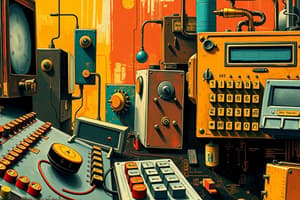Podcast
Questions and Answers
Who designed the IBM System/360 series of mainframe computers?
Who designed the IBM System/360 series of mainframe computers?
Which programming language was developed by Dr. Thomas Kurtz and Dr. John Kemeny?
Which programming language was developed by Dr. Thomas Kurtz and Dr. John Kemeny?
What significant development occurred in 1969?
What significant development occurred in 1969?
What was the first microcomputer designed by Ed Roberts?
What was the first microcomputer designed by Ed Roberts?
Signup and view all the answers
Which computer marked the introduction of a unique graphical interface in 1984?
Which computer marked the introduction of a unique graphical interface in 1984?
Signup and view all the answers
What significant technological achievement did the Intel 486 represent in 1989?
What significant technological achievement did the Intel 486 represent in 1989?
Signup and view all the answers
In what year did IBM offer Bill Gates the opportunity to develop the operating system for its new PC?
In what year did IBM offer Bill Gates the opportunity to develop the operating system for its new PC?
Signup and view all the answers
Which of the following was a feature of the IBM 286-AT released in 1984?
Which of the following was a feature of the IBM 286-AT released in 1984?
Signup and view all the answers
What was the primary function of Napier's Bones?
What was the primary function of Napier's Bones?
Signup and view all the answers
Who is known as the 'father of the computer'?
Who is known as the 'father of the computer'?
Signup and view all the answers
What significant innovation did Ada Lovelace propose for early computers?
What significant innovation did Ada Lovelace propose for early computers?
Signup and view all the answers
Which device marked the beginning of the first generation of computers?
Which device marked the beginning of the first generation of computers?
Signup and view all the answers
What was one major disadvantage of the first generation of computers?
What was one major disadvantage of the first generation of computers?
Signup and view all the answers
What pioneering device did Dr. Herman Hollerith create?
What pioneering device did Dr. Herman Hollerith create?
Signup and view all the answers
What was a key contribution of George Boole to computing?
What was a key contribution of George Boole to computing?
Signup and view all the answers
What type of machine did Blaise Pascal invent?
What type of machine did Blaise Pascal invent?
Signup and view all the answers
What was a primary feature of the ENIAC computer?
What was a primary feature of the ENIAC computer?
Signup and view all the answers
Who developed the UNIVAC I compiler?
Who developed the UNIVAC I compiler?
Signup and view all the answers
Which statement best describes the second generation of computers?
Which statement best describes the second generation of computers?
Signup and view all the answers
What was the first computer designed and sold commercially?
What was the first computer designed and sold commercially?
Signup and view all the answers
Which programming language was developed in 1957?
Which programming language was developed in 1957?
Signup and view all the answers
What challenges do early computers like the ENIAC face during operation?
What challenges do early computers like the ENIAC face during operation?
Signup and view all the answers
What key development allowed transistors to become essential in digital circuits?
What key development allowed transistors to become essential in digital circuits?
Signup and view all the answers
Which mathematician is associated with the concept of the Turing machine?
Which mathematician is associated with the concept of the Turing machine?
Signup and view all the answers
What is one of the advantages of third-generation computers using integrated circuits?
What is one of the advantages of third-generation computers using integrated circuits?
Signup and view all the answers
Which of the following is considered a disadvantage of integrated circuits?
Which of the following is considered a disadvantage of integrated circuits?
Signup and view all the answers
How does the energy consumption of third-generation computers compare to earlier computers?
How does the energy consumption of third-generation computers compare to earlier computers?
Signup and view all the answers
What technology is necessary for manufacturing integrated circuits?
What technology is necessary for manufacturing integrated circuits?
Signup and view all the answers
What is a limitation in the use of third-generation computers for executing large applications?
What is a limitation in the use of third-generation computers for executing large applications?
Signup and view all the answers
What method is used in third-generation computers to manage heat discharge?
What method is used in third-generation computers to manage heat discharge?
Signup and view all the answers
Which statement best describes the versatility of third-generation computers?
Which statement best describes the versatility of third-generation computers?
Signup and view all the answers
Which of the following is a characteristic of the first-generation computers compared to third-generation computers?
Which of the following is a characteristic of the first-generation computers compared to third-generation computers?
Signup and view all the answers
What is one of the significant advantages of fourth generation computers?
What is one of the significant advantages of fourth generation computers?
Signup and view all the answers
Which statement about fifth generation computers is true?
Which statement about fifth generation computers is true?
Signup and view all the answers
What is a disadvantage associated with fourth generation computers?
What is a disadvantage associated with fourth generation computers?
Signup and view all the answers
What feature of fifth generation computers contributes to their versatility?
What feature of fifth generation computers contributes to their versatility?
Signup and view all the answers
What is indicated as a requirement for operating fourth generation computers?
What is indicated as a requirement for operating fourth generation computers?
Signup and view all the answers
Which of the following is a characteristic of microprocessors in fourth generation computers?
Which of the following is a characteristic of microprocessors in fourth generation computers?
Signup and view all the answers
What is a disadvantage of fifth generation computers regarding their technology?
What is a disadvantage of fifth generation computers regarding their technology?
Signup and view all the answers
What technological advancement is associated with fifth generation computers?
What technological advancement is associated with fifth generation computers?
Signup and view all the answers
Study Notes
Early Computing Devices
- The abacus, originating from Asia, is the first known counting device. It works on a place-value system, where the position of a bead or rock determines its value.
- John Napier's Bones (1600s) was a manual calculating device used for multiplication and division.
- Blaise Pascal invented the Pascaline (1642), a mechanical calculator capable of adding and subtracting, as well as multiplying and dividing through repetition.
- Charles Babbage, the "father of the computer," designed the Difference Engine (1812). This engine would be steam-powered, fully automatic, and controlled by pre-programmed instructions.
- Ada Lovelace, considered the world's first computer programmer, developed the first algorithm designed for Charles Babbage's Analytical Engine. She proposed using a binary system for storage instead of a decimal system.
- George Boole developed Boolean logic in the 1850s, which became crucial for designing computer circuitry.
- Herman Hollerith introduced the first electromechanical, punched-card data-processing machine, used for compiling information for the 1890 U.S. census. His tabulator's success led to the creation of International Business Machines (IBM).
First Generation of Computers: Vacuum Tubes (1940-1956)
- Vacuum tubes, developed by John Ambrose Fleming in 1904, were the defining characteristic of first-generation computers.
- These computers were characterized by simple architecture, large size, high energy consumption, and slow processing speeds.
- They found applications in scientific and commercial fields.
- Key examples include the Turing Machine, developed by Alan Turing, and the Harvard Mark I built by Howard Aiken.
- ENIAC (Electronic Numerical Integrator and Calculator) used 18,000 vacuum tubes, weighed thirty tons, and occupied a large space.
- The first computer commercially sold, the UNIVAC I, was designed specifically for business data-processing applications.
Second Generation of Computers: Transistors (1956-1963)
- Developed in 1947 by John Bardeen, Walter Brattain, and William Shockley, transistors replaced vacuum tubes.
- These computers were smaller, consumed less power, and processed data faster than their predecessors.
- Key examples include the IBM System/360 series of mainframe computers, the first general-purpose digital computers to use integrated circuits.
- Dr. Grace Murray Hopper played a key role in developing the COBOL (Common Business Oriented Language) programming language.
- Ken Olsen introduced the PDP-I, the first minicomputer, marking a shift towards smaller, more affordable machines.
Third Generation of Computers: Integrated Circuits (1964-1971)
- The invention of the integrated circuit (chip), a collection of tiny transistors, defined this generation.
- Computers became even smaller, more energy-efficient, and more reliable.
- They were still expensive but more versatile and used for both commercial and general purposes.
- The Intel 4004 microprocessor was a major innovation, enabling the processing of four bits of data at a time.
Fourth Generation of Computers: Microprocessor (1971-Present)
- The first microcomputer, the Altair 8800, designed by Ed Roberts, launched the era of personal computing.
- The development of MS-DOS by Bill Gates led to the phenomenal success of Microsoft.
- IBM's introduction of the personal computer (PC) in 1981 revolutionized computing.
- Apple introduced the Macintosh in 1984, with its iconic graphical interface making computers more user-friendly.
- The Pentium microprocessor, with its 3.1 million transistors and 112 million instructions per second, marked significant performance advancements.
Fifth Generation of Computers: Artificial Intelligence (Present-Beyond)
- Fifth generation computing focuses on artificial intelligence, pushing the boundaries of computer capabilities.
- These computers aim to be even smaller, faster, more powerful, and capable of advanced tasks like voice recognition.
- Key areas of development include parallel processing, superconductor technology, and true artificial intelligence.
Studying That Suits You
Use AI to generate personalized quizzes and flashcards to suit your learning preferences.
Related Documents
Description
Explore the fascinating evolution of early computing devices, from the ancient abacus to the invention of the mechanical calculator by Blaise Pascal. This quiz delves into the contributions of pioneers like Charles Babbage and Ada Lovelace, highlighting key developments that laid the groundwork for modern computing. Test your knowledge on these important historical milestones!



